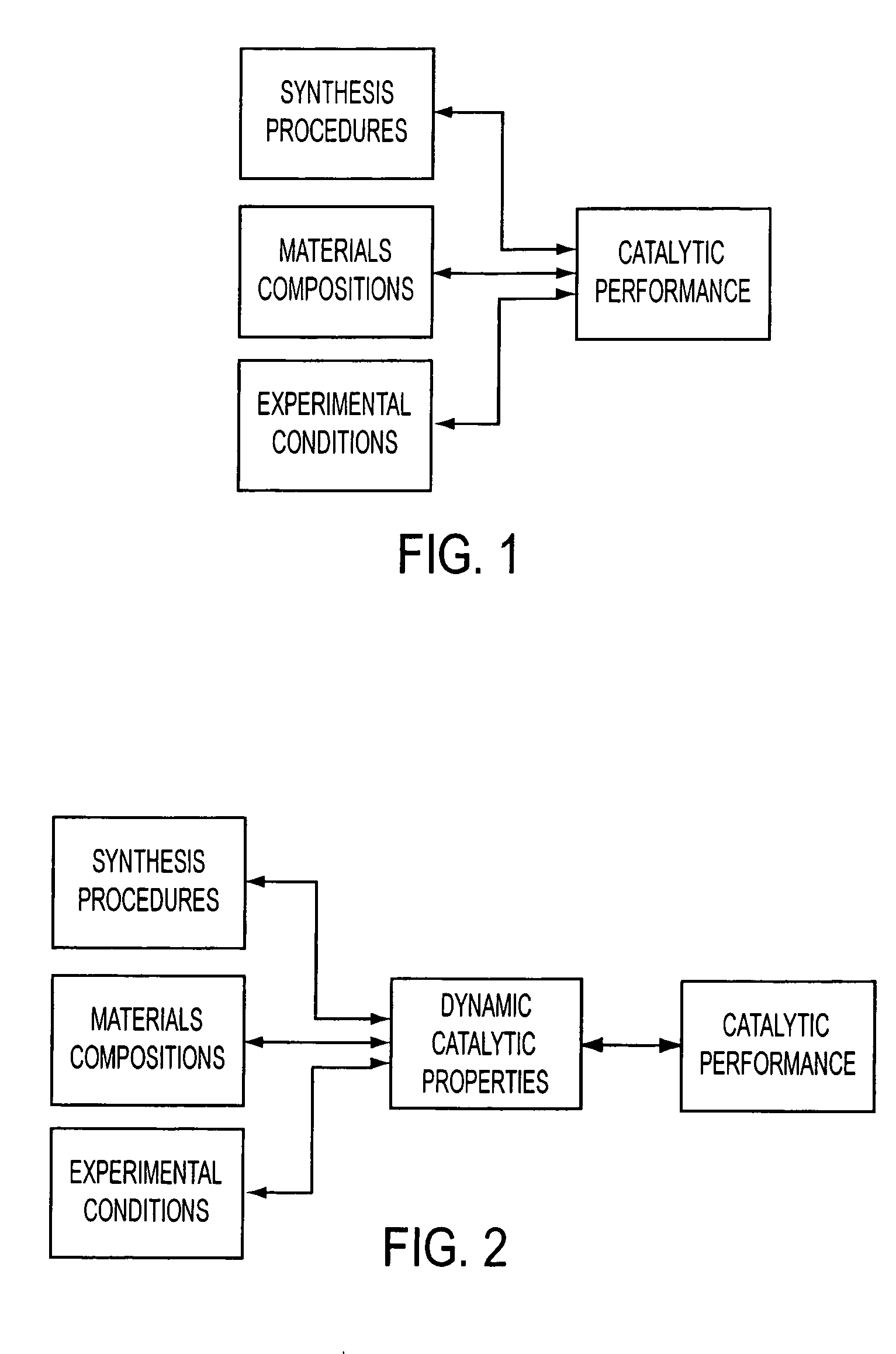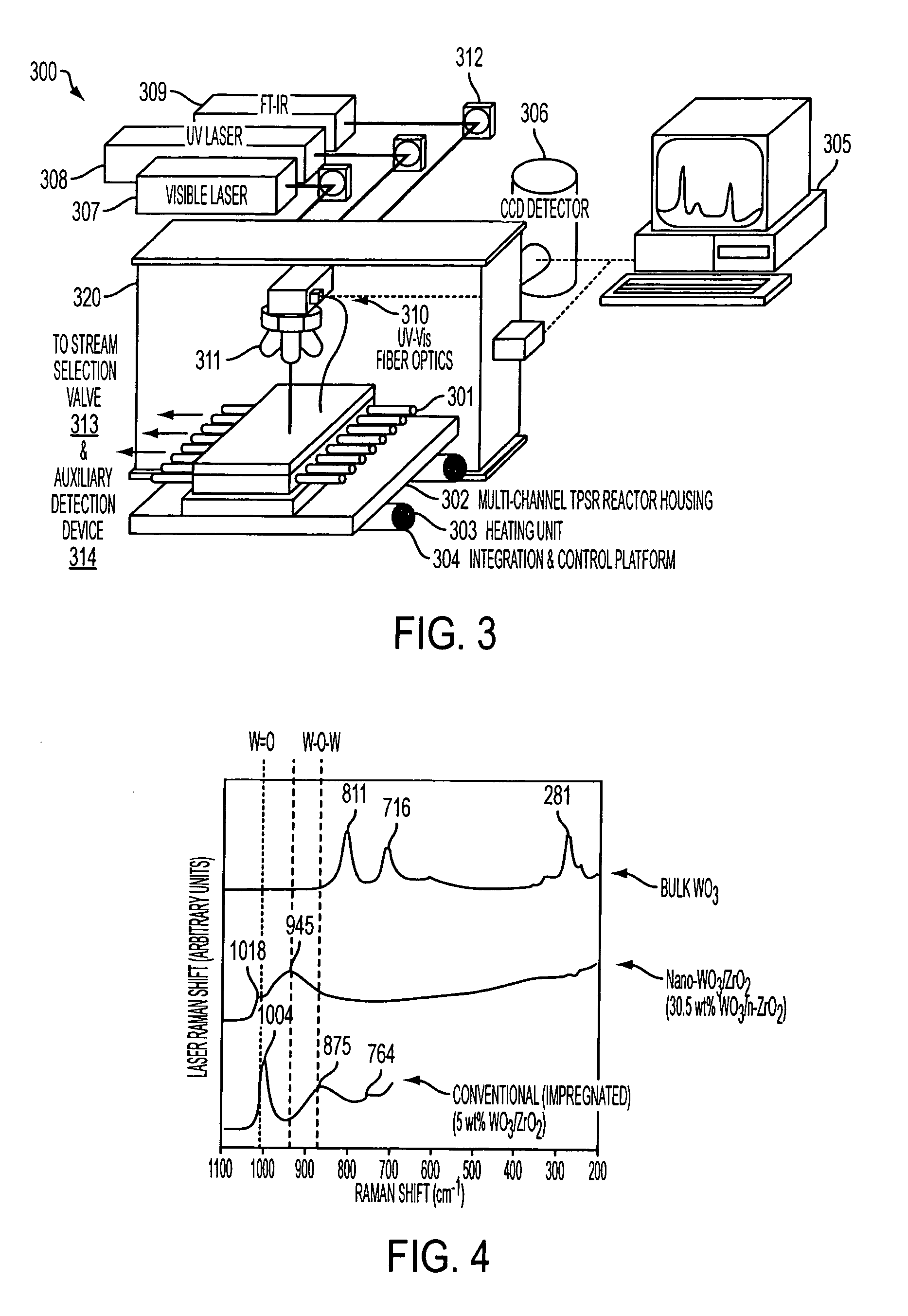[0022] Some aspects of the present invention are directed to a unique device and combinatorial method for targeted catalytic reaction screening of a plurality of catalytic materials simultaneously while determining the dynamic bulk and surface nature of the catalytic materials being screened, determining the molecular /
electronic structure-activity / selectivity relationship of the catalytic materials or, collecting information on the dynamic structures of the catalytic materials. One of the aspects of the present invention is therefore a device and related methodology that accelerates the discovery process of novel materials and reduce the associated costs. This and other aspects of the present invention use analysis of dynamic molecular structure-activity relations along with combinatorial methodologies to guide the accelerated exploration of new and unique catalysts.
[0023] Some aspects of the present invention are directed to a unique device that in addition to the optical spectroscopies described herein also includes optical
microscopy capabilities. Theses aspects of the present invention present a unique device that incorporates at least three optical spectroscopies and one optical
microscopy material characterization techniques into a combination with a thermal or pressure transient
spectroscopy characterization technique that measures
system response to changes in temperature, pressure or
partial pressure using systematic pulses or isotopically labeled molecules (e.g., Temperature Programmed
Surface Reaction (TPSR)
spectroscopy) into a single integrated device. These and other aspects of the present invention use the optical spectroscopic and microscopic characterization techniques to determine physical parameters of the material via the use of physical structural probes and use the thermal / pressure spectroscopy characterization technique to determine chemical parameters via the used of chemical probes that provide
surface chemical kinetic and mechanistic information. Some additional aspects of the present invention use transient versions of thermal and pressure spectroscopy characterization techniques (e.g., TPSR) to provide more detailed information on the
surface chemical kinetic and mechanistic processes, especially when evaluating steady-state catalytic reactions. Additional aspects of the present invention further enhance the information obtained by methods including, but not limited to, TPSR with the use of isotropic labels including but not limited to labels such as 2D, 18O, 15N, and 14C. Isotropic labels are currently used by those of ordinary skill in the art of catalytic studies to mark certain elements in order to determine location in product molecules, along with their affect on
kinetics during the reaction.
[0024] Another aspect of the present invention provides a device and related combinatorial methods that allow a large number of catalytic materials to be screened simultaneously while using optical spectroscopic / microscopic methods in combination with chemical spectroscopy, such as TPSR, to provide information on the dynamic bulk and surface nature of the catalytic materials as well as, but not limited to information on surface species being screened under in situ or operando conditions. Another aspect of the present invention is to provide a device and related combinatorial methods that allow a large number of catalytic materials to be screened simultaneously while using Raman, IR, and UV-Vis spectroscopic along with optical microscopic methodologies in combination with chemical spectroscopy, such as TPSR, to assist in determining the dynamic bulk and surface nature of the catalytic materials being screened as well as, but not limited to information on the surface species, determining the molecular / electronic structure-activity / selectivity relationship of the catalytic materials, or collecting information on the dynamic structures of the catalytic materials and surface species under in situ or operando conditions.
[0025] In contrast, current combinatorial screening approaches have not addressed the simultaneous, or near-simultaneous, development of detailed molecular and
electronic information on catalytic materials under
reaction conditions. At least one reason for this is that implementation of such a complex protocol would have hampered the number of catalytic materials to be screened with conventional devices and using traditional combinatorial methods, to a point where the main driving force in combinatorial studies, maximum number of samples screened per unit time, is lowered below acceptable levels. Combinatorial characterization methodologies have therefore been primarily developed to examine catalysts only before and after catalytic reactions. However, the catalytic active materials and its associated surface species under
reaction conditions are generally different than the catalytic materials and associated surface species present before or after catalytic reactions, thus leading to information that has limited value in materials development. Some aspects of the present invention use operando spectroscopy to evaluate, analyze or measure the properties of the catalytic material and its associated surface species during the reaction thus providing a greater quantity of detailed information that further accelerates material research. Additionally, current combinatorial methods have failed to integrate chemical spectroscopy (e.g., TPSR) due to focusing on maximum number of samples processed and current interest being limited to steady-state performance.
[0026] Chemical
spectroscopy methods, including but not limited to TPSR, further enhance the chemical information available from steady-state studies by providing information useful in the development of activity and / or selectivity relationships. TPSR generally is used to determine the
temperature response of reactions in order to provide information usefully to deduce catalytic reaction mechanisms and
kinetics. TPSR spectroscopy devices generally consist of a
chemical probe molecule with a defined temperature rise as a function of
time profile in which reaction products are detected as a function of temperature by
mass spectrometry. TPSR spectroscopy can be used to provide information useful in deduction of reaction mechanisms, bonding mechanisms between adsorbates and the adsorbing surface and functional group nature. TPSR spectroscopy can be used to measure properties under reaction conditions and is generally applied in two ways when studying
kinetics of active catalytic surface sites, including but not limited to rate determining step determinations, reaction order and
activation energy. One manner of TPSR spectroscopy is to coadsorb gases on a catalyst surface after which heating is done with an
inert carrier gas (e.g., He). Another manner uses a catalyst with preadsorbed surface species which is subsequently heated in a reactive carrier gas (e.g., CO). This manner of TPSR can also provide information useful for
quantitative determination of adsorbate coverage. Some aspects of the present invention combine TPSR spectroscopy with the optical spectroscopy and
microscopy described above to determine dynamic bulk and surface nature of the catalytic materials being screened as well as, but not limited to information on the surface species, determining the structure-activity / selectivity relationship of the catalytic materials, or collecting information on the dynamic structures of the catalytic materials and surface species under in situ or operando reaction conditions. Similarly, other chemical spectroscopic techniques may be used to create pressure or
partial pressure transients and measure a systems reaction thereto in a similar fashion as TPSR.
[0027] Another aspect of the present invention provides for one or more combinatorial catalyst development libraries (from the chemical and optical spectroscopies described above) that may be developed using the devices and methodologies according to other aspects of the invention. A searchable
library of the molecular-based information process can decrease the number of future samples to be screened and improve economic efficiency along with accelerating timelines for future discovery processes. Generally, the
library would store the molecular-based information that provides a fundamental basis for understanding the targeted reaction. Further, the fundamental molecular structural information may allow the use of the molecular / electronic structural-physical and chemical relationships in other targeted applications. Over time, it is expected that the use of such molecular / electronic structure-property libraries for other targeted applications may further decrease the number of samples that will need to be screened and further accelerate the discovery of novel materials.
 Login to View More
Login to View More  Login to View More
Login to View More 


